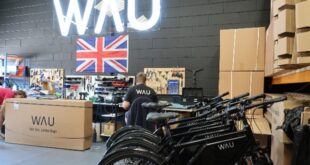It’s been a few months (see BikeBiz August) since we wrote about just one way of getting the back of a beer mat bike idea to within a hair’s breadth from a tangible product. To continue our journey, we need to find manufacturing partners to produce the product. You should have some computer-aided design (CAD) drawings and a handful of 3D-printed prototypes to wave in front of anyone who will listen.
As mentioned previously, this is a great time to hatch the idea that has been playing on your mind onto the shop floor with the power of freelancers, 3D printing, international manufacturing and crowdfunding. This part of the process was compiled from our experience of developing Trigger Bell, a safer bike bell, and the lessons learnt throughout (of which there were many!). Do get in touch if you would like the names of specific sites and companies referenced in this article or any other information.
We will be covering how to find companies to manufacture and assemble your product. We will leave sales and funding activity, as well as the protection of your precious intellectual capital, to another day. There is lots of material online to help in these areas, while manufacturing still remains remarkably opaque.
We have to first set expectations. This process (finding your manufacturing partners) is a few months of work. After this, actually getting to the point of having a physical product ready for sale is not a short process. It may take a further six to 18 months to iron out all of the manufacturing kinks and unveil a finished product. Manufacturing is not cheap. While finding partners is very low cost, be prepared for a five-figure investment to get the product made. Finally, things will not go to plan. Brace yourself to have to count to ten and rethink your options numerous times! It would be boring if it was easy. In a nutshell:
1. I can learn – soak up as much as you can about manufacturing terms and processes
2. Three lions – start your search on your doorstep
3. International love – look at options for international manufacture
4. Money, money, money – get your costs crystal clear
I can learn
Immerse yourself in manufacturing terminology as it is a completely different language. Imagine landing in Almaty and then riding 500 miles into the sticks. Without a way of conversing, you will be reduced to wild gesticulations and will repeat (perhaps costly) blunders. Your prototype designer may be able to get you started before you venture out on your own.
Google and YouTube are your friends. Manufacturing is a fascinating and awe-inspiring place when you see what actually goes into making even simple products. You will never look at a spork in the same way again.
If you are yet to pick a material now is the time to get to grips with the options, their properties and uses. There are dozens of different types of plastics and metals and hundreds of variants of each. Most plastic products have material marks on them to help recycling (those numbers in the triangles). There are online resources that will help you identify ranges of suitable materials to use.
Understand the different processes that are performed to manufacture components from these materials. Processes for plastics include injection moulding, extrusion and vacuum forming and for metal fabrication include machining, stamping and extrusion.
Remember those samples you bought while designing your product? It is time to dust those off and take a closer look at them. Are the materials hard, tough, ductile or elastic? Yes, you guessed it, these have very specific engineering definitions and will again help you to identify the right material or at least describe the right material.
Other areas to look at are fasteners (are you going to fasten the components together using rivets, screws, bolts or go for adhesive, fusion bonding or ultrasonic welding) and material finishes (techniques may sound similar but are distinctly different –“electroplating” versus “e-coating” anyone?). Do keep in mind the need to do the same for packaging (design, prototype and manufacture).
The more time spent understanding and investigating these terms, the more valuable the conversations you can have with manufacturers which may in turn dramatically reduce your production costs and time. A bug in software may take a few hours or days to fix. Changing an injection moulding tool or stamping die can take months and cost thousands. Believe me, we have been there.
Finally, just like with the prototype, keep that customer benefit in mind. If what is achievable with a process will negatively affect the benefit then it is worth looking at different processes and materials. Delivering the benefit is not just the icing on the product cake but is the essential ingredient of a successful product.
Three lions
Now it’s time to get the professionals involved. There is no better place to start finding manufacturers than the excellent manufacturers on your very own doorstep, so it is back to Google to put the new knowledge into practice. You will find a huge array of companies from specialists in a specific process or material to those that are able to manufacture and assemble the components of entire products.
Get in touch with as many as possible and if you are worried about sharing your idea, a simple Non-Disclosure Agreement will help to ease your concerns. In return for clear requests, in manufacturing language, everyone will want to help. Sending ambiguous questions with imprecise drawings and asking for a quote may, however, lead to ghosting.
Using a set a 2D diagrams, CAD files, 3D prints and an indication of material choice and volumes, you will be able to get quotes for tooling, unit costs and lead times. Even better, many people will help to refine your idea further or make it more cost effective to manufacture. You may be able to convert bespoke parts into standard, off-the-shelf components which can be sourced more quickly and cheaply or use a more appropriate material or fastening method. This is the difference between the visionary architect (the product designer) and the practical builder (the manufacturer).
One thing that may be surprising is how many different parties may need to get involved to supply all the components. For a bike bell, this includes the bell stamper, coater, screw supplier, spring maker, injection-moulder and assembler. Do ask if your manufacturer can perform the assembly and packaging (rather than requiring a third party) and if they have relationships with anyone who can supply other required components as this will make your life easier. Finally, it is good to get the different companies talking directly with each other, especially when confirming part tolerances and assembly options.
International love
Sourcing from our own shores is great, but it may be worth dipping a toe into the waters of international sourcing such as from Asia or Europe. There are a number of free websites that can help. Often all you will have to do is post a request and some diagrams and within 48 hours you could have dozens of quotes available to you from a range of companies and countries.
Will you get your parts cheaper than the UK? Very likely. But the costs quickly start to mount up. Remember to take into account language barriers, time zones, quality assurance, shipping (cost and duration) and import taxes. Sourcing standard components obviously carries significantly less risk than something bespoke. Given how easy it is to get quotes from abroad, it is definitely worth giving it a go if there is a low risk of losing any intellectual property.
Money, money, money
So within a couple of months, you should have all of the partnerships needed to manufacture your product, and perhaps more importantly, to calculate accurate costs. You are at a critical milestone as you can now work on your business plan. All being well, the price that customers will pay for the benefit of your product will cover the costs that you now have a clear idea of and leave a reasonable profit margin for your efforts.
Congratulations. If you have made it this far, you should have a product that makes commercial sense and partnerships with manufacturers that will get your product manufactured and assembled. During this stage, you may have started protecting
your idea and working on funding the tooling and the first production run. It is a very exciting time indeed.
 BikeBiz Bicycle and cycling retail news
BikeBiz Bicycle and cycling retail news




